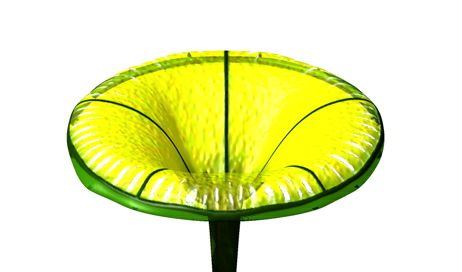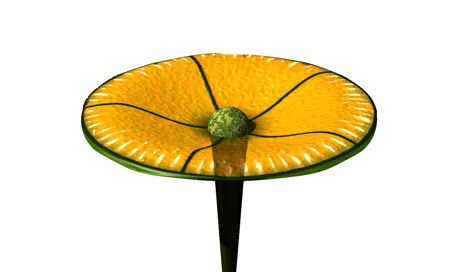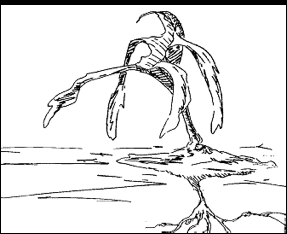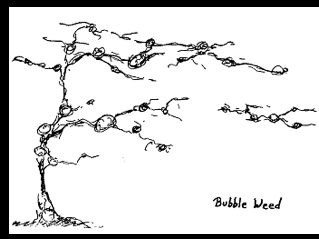Early Plants

Autotrophs lie at the base of any food chain since they are able to use sunlight to produce biomass. Although the lagoon waters contain microscopic planktonic plants washed in from the oceans, they were also host to a number of more sophisticated, macroscopic forms that could only thrive in the calm shallows within. Some of these are evolved from plants that originally were based on the land when it was last habitable. The Tiered Seaweeds are anchored by shallow roots into the sea bed from which they obtain mineral nutrients like a land‑based form. They obtain carbon dioxide, however, from leaves modified into specialized gas exchanging fronds that they dangle in underwater currents. (Remember, at this pre‑warm spell stage there is still too little CO2 in the atmosphere to permit productive photosynthesis).
 Since the waters of the lagoons are turbid, the weeds find it advantageous to raise their leafy crests above water to catch undiluted sunlight. These plants are curiously segmented, being formed out of "tiers" of roughly uniform length (2‑3 feet long). One leafy photosynthetic tier rises above the waves, 1‑3 tiers directly below adapted to sub‑surface photosynthesis, several gas exchange/stem tiers, and a root tier. The number of tiers depend on the depth of the water; their individual length does not vary much and so in areas ideal for their growth, tiered seaweed can been seen growing in spaced ranks, each row seawards adding a tier, right up to the tube worm barrier. A single tier species exists that lives in shallow pools at the sea edge and which combines leaves, fronds and roots in one piece. Obviously, such an important primary producer would be prey to both surface skimming and underwater herbivores.
Since the waters of the lagoons are turbid, the weeds find it advantageous to raise their leafy crests above water to catch undiluted sunlight. These plants are curiously segmented, being formed out of "tiers" of roughly uniform length (2‑3 feet long). One leafy photosynthetic tier rises above the waves, 1‑3 tiers directly below adapted to sub‑surface photosynthesis, several gas exchange/stem tiers, and a root tier. The number of tiers depend on the depth of the water; their individual length does not vary much and so in areas ideal for their growth, tiered seaweed can been seen growing in spaced ranks, each row seawards adding a tier, right up to the tube worm barrier. A single tier species exists that lives in shallow pools at the sea edge and which combines leaves, fronds and roots in one piece. Obviously, such an important primary producer would be prey to both surface skimming and underwater herbivores.
Another plant evolved to cope with the low atmospheric CO2 problem on Coti Mundi is the Bubble Weed. This is a pelagic, or wandering, plant which floats on the surface and dangles roots below. Its strategy is to store CO2 extracted from the water by the roots and a smaller contribution from dark respiration in gas filled vesicles in its tissues. Its leaves therefore look like green bubble‑wrap and when the lights turn on the next day it has ample CO2 available for biomass production. Bubble weed therefore has the ability to grow in sudden spurts and since it is free floating is found in small numbers almost anywhere. It is an opportunist capable of explosive growth in areas where competition may be lacking and, as we shall see, was one of the first macroscopic plants to re‑colonize the land.
The Floating Island plant  looks a little like a shrub, bobbing on a buoyant float made from roots which supported not just the plant, but a mesocosm of its own specially adapted symbiotic life‑forms.
looks a little like a shrub, bobbing on a buoyant float made from roots which supported not just the plant, but a mesocosm of its own specially adapted symbiotic life‑forms.
Another symbiote is the Moss Sponge, a large porous stony secretion, roughly spherical, and several feet across that sits in the shallows with its top above water. Wave and capillary action flushes water through the structure where it is cleansed of suspended organic matter by the microscopic colonial organisms within. The respiration of the "sponge" and its release of mineral nutrients and CO2 permits a moss‑like plant growth on its upper surface. Dead moss leaches into the underlying sponge and is consumed.

